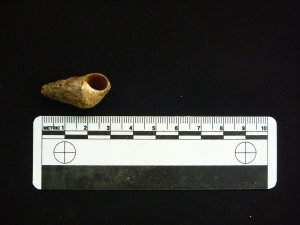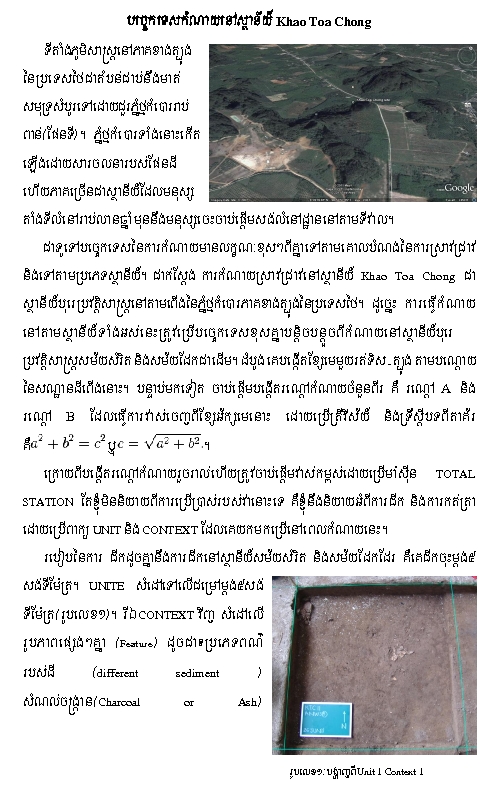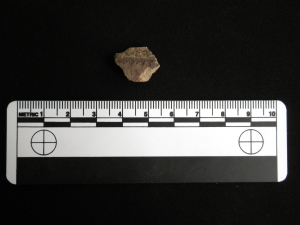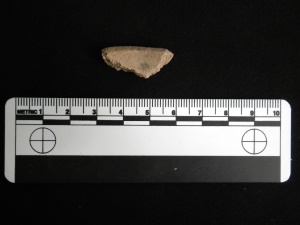Archive
Interpretation about Breakage Patterns and Cut Marks
There are several questions that can be answered about past cultures when examining shell and faunal remains in context. At hand, and in our analysis group, several cut marks have been identified on bone in addition to some breakage patterns of shell. This may present a curious case of purpose exhibited from the remains, telling us that food preparation and cooking has occurred here. If this is the case then it can be assumed that this rock shelter was a home to our great ancestors.
In addition cultural implications such as favored meals, resource abundance or depression (meaning more or less food availability found within the trenches), as well as the season can eventually be determined- specifically from the shell found. Perhaps exhibiting the purpose behind the culture of the rock shelter, as well as the specific time when it was inhabited. The cut marks on the bones are identified as mammalian long bones (legs or arms of the animal, wherein the easiest accessible amount of meat stretches), there is as well as a pattern of breakage on gastropod shells (snail like shells). These patterns of breakage imply the use of tools, the difference between breakage patterns can be assumed to illustrate the use of different sizes of tools. Larger cuts versus smaller cuts are in correlation to larger tools versus smaller bones, in addition to larger shell breakage compared to minimal breakage. One of the master students I worked with on day 22 in analysis noticed several patterns, kindly enough he showed me his findings, which we presume to be the evidence provided.
Inasmuch, recent findings provide stone adze and artifacts which support the idea that tools were used to cut the meat off these mammal’s bones, as well as to break a shell open to grab the meat. [HGVV]
Tooth Morphology!
Tooth morphology is one of the ways an archaeologist studies a person or animals diet. They are able to determine the source where a person or animal has originated from by what they eat. One way to do this is to study the isotopes in the excavated teeth recovered from a site. They examine things like dental records to identify a person, dental caries(cavities), what species and family the teeth derive from.
They do this by using a cladistic classification system to distincly classify the teeth into first a general catagory such as analogous structures.The first and last appearance in the fossil record. They further break the identification into family species and so on by using a family tree to break all the identification into catagories unique to a species. This system used was created by Charles Linneaus.
Some of the most impressive finds we have excavated during the field school have been of a cervidae. These teeth belong to a local prehistoric deer present in Thailand during the Pleistocene era. We have also uncovered many primate teeth. This is interesting because it can help us to examine what was in humans diets during occupation at a site, their age and their origin. Studying  biological archaeology is all that it needed in order to study tooth morphology.
biological archaeology is all that it needed in order to study tooth morphology.
AMH
Perekaman Data Dari Lapangan
Semua data yang didapatkan selama proses ekskavasi di lapangan harus segera direkam di atas kertas dan kemudian disimpan ke dalam sistem komputer. Data-data tersebut antara lain berupa jenis artefak, jenis ekofak, keletakannya, kedalaman, progresifitas ekskavasi sehari-hari dan lain-lain. Biasanya semua data-data tersebut disimpan ke dalam format Microsoft Word Excel dalam bentul tabel.
Dalam penggalian kali ini yang dipimpin oleh Dr. Ben Marwick, data lapangan selama ekskavasi disimpan ke dalam format Microsoft Access 2010. Program ini dirancang untuk memberikan kontrol lebih dan untuk mengurangi kesalahan dalam pemasukan input data ke dalam komputer. Dalam aplikasinya untuk menyimpan data arkeologis, program ini dirancang untuk memilah data dari yang umum untuk menjadi sangat spesifik. Data akan dibuat dalam bentuk networking yang saling berhubungan dan dapat dipila-pilah dan dilihat melalui kategori yang dibuat oleh si perancang network data.
Dalam program database terdapat tiga tipe program dasar yang sangat penting yaitu: a. “tables” yaitu tabel untuk menyimpan data sesuai input aturan dan batasan; b. “forms” yaitu formulir untuk membuat input data menjadi lebih cepat dan akurat; c. “queries” yaitu untuk menghimpun data dan untuk melakukan analisis dasar. Dengan program yang luar biasa ini, tabel-tabel dapat saling dihubungan secara bersamaan dengan bentuk networking sehingga dapat menyederhanakan input data dan memudahkan analisis.Perekaman data dengan cara ini akan sangat bermanfaat dalam hal mengurangi faktor human error dalam pemasukan data dan data yang masuk ke dalam program ini akan sangat terkontrol.
Program database menurut saya sebaiknya dikerjakan setelah selesai bekerja dari lapangan. Program ini sedikit rumit dan dalam input data akan menyebabkan banyak kebingungan. Data temuan selama ekskavasi di lapangan akan sangat bervariasi serta tidak terduga dan lebih baik dimasukkan ke dalam excel yang lebih fleksibel dalam pemasukan data. Setelah semua data didapatkan maka baru dimasukkan ke dalam program database. Pada akhirnya program excel akan memiliki keterbatasan dibanding program access, oleh karena alasan tersebut maka input data lapangan dalam penggalian kali ini dibuat dalam format access.
Sinaunang Bato, Sinaunang Tao


Isa sa nakakatuwang karanasan ko dito sa KTC site ay ang makahukay ng batong hinulma ng mga sinaunang tao o ang mas kilala bilang “stone adze”. Nitong byernes lang, naatasan akong maghukay sa Trench B, sa bahaging hilagang-silangang parte kung saan aking napagtanto ang batong ito. Bago pa ito mangyari, nakahukay din ang aking kasama ng dalawang buong palayok na sinasabing hindi karaniwang porma sa Thailand. Ang bato at mga palayok ay humigit kumulang nasa 2,000 – 4,000 taon gulang na, o nasa tinatawag nilang “Neolithic Period”. Ito ang panahon kung saan yumayabong at napapabuti ang teknolohiya ng mga tao noon.
Nang aking mahukay ang nasabing bato, maraming mga basag na palayok ang nakapalibot din kalapit nito. Kukunin na sana namin ang lalim ng mga palayok na ito at kasama na rin ang batong ito na aking napagkamalang palayok din dahil sa halos kaparehong kulay na itim at may nakadikit pang lupa. Mahirap itong makilala sa unang tingin. Nang akin ng pinulot, ako ay nagtaka kung bakit ito pino at makinis, hindi isang karaniwang paglalarawan sa mga iba’t ibang palayok na aming nahuhukay ng mga ilang araw na. Aking sinubukang tanggalin ang lupa gamit ang aking mga daliri at nagulat ako sa kanyang porma na halos katulad ng mga batong nakita namin sa Thungwa Ancient Elephant Museum.
Ang mga makinis na batong ito ay sinasabing ginagamit ng mga sinaunang tao noong panahong hindi pa uso ang metal. Karaniwan, ito ay ginagamit upang pakinisn at pagandahin ang ukit ng kahoy. Ang mga kahoy na ito ay maari rin nilang ginamit sa pagputol o pagtabas ng mga puno o troso na posibleng ginamit din sa pangangahoy, paggawa ng bangka, bahay at kung ano pa. Ang paggamit ng mga batong ito ay sinasabing kaakibat din ng paglago ng agrikultura ng mga lugar kung saan makikita ang ebidensya na ito.
Sa Pilipinas, meron din tayong ganito. Isa sa mga sikat na archaeological site ay ang Ille Cave, mas malaki sa KTC site. Bisitahin ang website para makuha pa ng karagdagang impormasyon: http://www.solheim-foundation.com/Online%20Articles/Ille_Adzes.pdf
อะไรอยู่ในหม้อ ?
หลังจากการรอคอยมาประมาณสองสัปดาห์ ในที่สุดเราได้ขุดค้นพบภาชนะดินเผาสองใบ ที่มีสภาพเกือบสมบูรณ์ อยู่ในระดับความลึก 1.15 เมตร จากระดับปากหลุมขุดค้น B การค้นพบครั้งนี้เป็นสิ่งที่มอบยินดีแก่ทุกคนในคณะขุดค้น เพราะก่อนหน้านั้นเราเริ่มพบโบราณวัตถุน้อยมาก ภาชนะดินเผาสองใบนี้เลยเป็นสิ่งที่กระตุ้นความสนใจแก่พวกเราอีกครั้ง
พวกเราได้เก็บภาชนะดินเผาทั้งสองใบขึ้นมาทำความสะอาดและตรวจดินที่อัดอยู่ในภาชนะ ภาชนะใบแรกมีรูปทรงเป็นทรงพาน ตกแต่งด้วยลายเชือกทาบ ส่วนดินที่อยู่ในภาชนะนั้นเราพบ ชิ้นส่วนของกระดูสัตว์ที่ถูกเผาไฟและฟันของสัตว์จำพวกลิง (Macaca sp.) ส่วนในภาชนะใบที่สอง เป็นรูปทรงหม้อก้นกลม ตกแต่งด้วยลายเชือกทาบบริเวณก้นภาชนะ ภาชนะใบนี้ไม่สมบูรณ์นักเป็นเมื่อเอาดินด้านในออก ภาชนะดินเผาจะแตกออกเป็นชิ้นๆ เมื่อตรวจสอบดินภายในภาชนะดินเผาใบที่สอง เราพบ เศษเปลือกหอย และกระดูกสันหลังที่ไม่สมบูรณ์ของพวกตะกวด (Varanus sp.)เพียงหนึ่งชิ้น จากการสังเกตุเนื้อดินพบว่าภาชนะดินเผาทั้งสองลูกเนื้อดินมีลักษณะหยาบ แสดงถึงเทคโนโลยีการผลิตที่ยังไม่พัฒนานัก และใช้อุณหภูมิในการเผาไม่มาก และกระดูกสัตว์ทั้งสองชนิดที่พบก็เป็นกระดูกสัตว์ที่พบทั่วไปในหลุมขุดค้นในทุกระดับที่ขุดมาก่อนหน้านี้
จากความคิดของข้าพเจ้าคิดว่าเศษกระกูกสัตว์และเปลือกหอยที่พบในดินที่อยู่ในภาชนะ น่าจะไม่เกี่ยวข้องกับสิ่ของที่คนในสมัยก่อนเป็นผู้บรรจุไว้ลงในภาชนะทั้งสองเพราะ จำนวนกระดูกและเปลือกหอยที่พบนั้นน้อยเกินไป การพบเศธกระดูกและเปลือกหอยอาจเกิดจากกระบวนการทางธรรมชาติที่ดินในบริเวณนั้นได้เข้าไปแทนที่ช่องว่าในภาชนะดินเผา ถ้าเป็นอย่างนั้นจริงอย่างน้อยเราก็ได้ค้นพบภาชนะดินเผาสองใบที่เกือบจะสมบูรณ์ เพื่อใช้ในการศึกษาอย่างอื่น เช่น เทคโนโลยีในการผลิต วิถีชีวิตรของคนในสมัยก่อน แล้วในตอนนี้
ศุภลักษณ์ หมีทอง (PANG)
Ceramic analysis update
As we dig deeper at the KTC site, the ceramic finds seem to become more and more interesting when comparing the two trenches along with comparing what is occurring within the trench to other portions of the trench.
Perhaps the most significant difference observed is between trench A and B and the amount of pottery found with decoration. Trench A has significantly larger portions of pottery for at least the first several units but overall the pottery has around 15% less potsherds with decoration than trench B. If this trend continues, this could indicate a difference in the use of space around the site in past times.
Another notable feature that seems to be observed in the pottery decoration that I noticed today and could be potential for further research is that the decoration lines seem to change in depth depending on the colour of the potsherds. On the lighter coloured potsherds (light brown to gray), they either have no decoration at all or the decoration lines that we have observed are thin and are not deeply carved into the pottery; however, the dark brown or black potsherds have very deeply cut lines into what appears to be the vast majority of the potsherds that are found with that particular colouring. If this turns out to be for the most part the case, this could indicate a different tool was used for the different type of pottery or that the material limited the design somehow.
As we have dug deeper into trench B and discovered some very interesting fully intact ceramic vessels, I think the pottery analysis for KTC is only going to get more and more interesting. The pictures above exemplify the decoration or non decoration that seems to be associated with the colour of pottery so far.
อากาศผลันแปร ความหลากหลายแปรผลัน
การเปลี่ยนแปลงของสิ่งแวดล้อมในอดีต ส่งผลต่อการเปลี่ยนแปลชนิดของสัตว์ที่ ไม่เพียงเฉพาะพื้นที่นี้พื้นที่เดียวเท่านั้น การเปลี่ยนแปลงทางด้านสิ่งแวดล้อมสามารถเกิดขึ้นได้ในต่างพื้นที่ ต่างช่วงเวลา ในพื้นที่แหล่งโบราณคดีเขาโต๊ะช่อง จ.กระบี่ จากการสังเกตการเปลี่ยนแปลงที่เกิดขึ้น พบว่า
สัตว์ที่พบในช่วงแรกของการขุดค้น เมื่อลงลึกในรายละเอียดพบว่า โดยส่วนใหญ่จะเป็นสัตว์สามารถเคลื่อนไหวได้อย่างรวดเร็ว จากขนาดของร่างกายที่เล็ก หรือมีความคล่องตัวสูง ตัวอย่างที่เห็นได้ชัดที่สุดน่าจะเป็นกระดูกสัตว์ของสัตว์ประเภทตระกูลไพรเมท (primate) ที่พบเป็นจำนสนมาก และเมื่อวิเคราะห์ลงในรายละเอียดจะพบว่า ส่วนใหญ่อยู่ในลิงวงศ์ Macaca sp. รวมไปถึงสัตว์ฟันแทะขนาดเล็กและขนาดกลางทั้งหลาย ซึ่งเมืลงลึกขึ้นในรายละเอียดด้านถิ่นที่อยู่อาศัยของสัตว์ที่กล่าวมานั้น พบว่าสามารถอยู่อาศัยได้ในหลากหลายพื้นที่ตั้งแต่พื้นที่สูงจากระดับน้ำทะเล ไปจนถึงสภาพแบบป่าชายเลน รวมถึงป่าฝนเขตร้อนอย่างในปัจจุบัน รวมไปจนถึงสัตว์เลื้อยคลานและสัตว์ครึ่งบกครึ่งน้ำทั้งหลายที่ ไม่ว่าาจะเป็น ตะกวด แลน (Lizzard) งู (snake) เต่า (turtle) ต่างก็สามารถอาศัยได้ในทุกสภาพพื้นที่ หลากหลายประเภท ใกล้น้ำ ดงดิบ ที่สูง ไปจนถึงชายฝั่ง
จาการขุดค้นในช่วง 1-2 วันที่ผ่าน (บทความนี้จัดทำขึ้นวันที่ ๘ ก.ค. ๕๔) ได้พบความเปลี่ยนแปลงบางอย่างที่เกิดขึ้นในพื้นที่แหล่งโบราณคดี คือ เริ่มมีการพบชิ้นส่วนกระดูกของสัตว์เลี้ยงลูกด้วยนมขนาดใหญ่ อย่างเช่น กวาง (Cervidae) และ วัว ควาย (Bovidae) สัตว์ที่กล่าวมาในช่วงแรกของการขุดค้น นั่นคือการเพิ่มขึ้นของสัตว์เลี้ยงลูกด้วยนมขนาดใหญ่ แต่นั่นไม่ได้แสดงว่าสภาพแวดล้อมยังคงเป็นแบบเดิมแต่อย่างใด กลับกลายเป็นว่าสภาพแวดล้อมในช่วงดังกล่าวจะมีลักษณะที่เป็นป่าโปร่ง และทุ่งหญ้า เพราะเป็นสภาพที่สัตว์ที่เพิ่มขึ้นมาสามารถนั้นสามารถอาศัยอยู่ได้
สิ่งที่กล่าวมาแสดงให้เห็นถึงการเปลี่ยนแปลงในอดีตที่ผ่านไปของพื้นที่ ที่เกิดขึ้นในช่วงเวลาที่แตกต่าง การเปลี่ยนแปลงที่เกิดขึ้น เป็นผลจากการเปลี่ยนแปลงสภาพอากาศที่ส่งผลต่อการเปลี่ยนแปลงภูมิประเทศ สภาพแวดล้อม ยังผลให้ชนิดของสัตว์เปลี่ยนแปลงไป ไม่เพียงเฉพาะส่งผลต่อสัตว์เท่านั้น สิ่งมีชีวิตประเภทอื่นๆก็เปลี่ยนแปลงเช่นเดียวกัน ไม่ว่าจะ้เป็น พืช สัตว์ไม่มีกระดูกสันหลัง รวมไปถึงสิ่งไม่มีชีวิตต่างๆในพื้นที่ ก็เกิดการเปลี่ยนแปลงด้วยเช่นกัน หากจพูดถึงการเปลี่ยนแปลงทางด้านสิ่งแวดล้อม ยังมีสิ่งที่ต้องทำอีกมากมาย ไม่เพียงแค่กระดูกสัตว์ที่จะสามารถบอกเรื่องราวดังกล่าวได้ ที่กล่าวมาเป็นเพียงส่วนหนึ่งในการอธิบายการเปลี่ยนแปลงสภาพแวดดล้อมในพื้นที่ ยังคงต้องอาศัยการศึกษาทางด้านอื่นอีกเพื่ออธิบายความเปลี่ยนทั้งหลายที่เกิดขึ้น
บริสุทธิ์ บริพนธ์
Faunal Analysis In the Upper Layers Pt. 2
So far our team’s excavation of KTC has been particularly exciting. Each day, as we dig deeper, different artifacts and features are discovered depicting an interesting overview of the history in our region. My work analyzing the faunal material has been equally exciting in the results it has already shown. As previously stated in the upper units phalanx and vertebral elements were surprisingly abundant in trench A. Now having looked over successive layers I have reached a depth of roughly 0.15 meters below the surface, providing a better overall picture of the finds. Interestingly, the findings are still providing the same overall picture.
In trench ASW excavation unit 1 there were very few finds but the phalanges and vertebrae each made up 10% of the overall faunal assemblage. Excavation unit 2 contained even more of these, with phalanges at 26% and vertebrae at 27% of the overall assemblage. For the SW quadrant, unit 3 showed a drop in the abundances of these elements with phalanges representing 12% and vertebrae 6% but they remain amongst the most frequently represented skeletal elements.
Importantly another element which seems to continually appear is turtle shell. In ASW1, 18% of the assemblage was turtle shell, this dropped in excavation unit 2 to 1% but rapidly increases in unit 3 to 20%. This may suggest that in the upper units some sort of mixing of the sediment has occurred because of the relatively slight excavation depths. Either way, in the overall understanding of the site 0.15 meters is undoubtedly full of recent deposits. With this, as we dig deeper and my anaylsis continues, a better understanding of the site dynamics may be understood.
As with ASW, the faunal assemblage in ASE has also provided some interesting information. In excavation unit 1 phalanges amount to 23% of the assemblage, while vertebrae account for 15%. Although I have not inputted the data for excavation unit 2, in ASE3 phalanges account for 8% and vertebrae for 5%. This indicates a drop in the abundances of these two elements between unit 1 and 3. On the other hand, in ASE1 turtle shell accounts for 5%, then in unit 3 jumps to 22%. There is also an increase in cranial elements from unit 1 to 3 at 0% to 24%. In this type of situation the data provided by this simple analysis may be misleading. There is a large increase in cranial elements at ASE3 but without data for ASE2 or successive units after, it is difficult to put this information into context. Also it is important to always remember that taphonomic processes may readily fragment crania because of their low density. This type of problem is difficult to address when dealing with faunal analysis because rarely in archaeological assemblages are intact bones found. Still with this, by taking percentages from the known elements as a whole, the data still provide a rough depiction of the activity taking place at KTC.
Overall the trends in elements seem to show a general pattern over time. Turtle bones appear to increase as mammal vertetbrae and phalanges decrease as we go back in time. Although this timeframe is short at the moment, with continued analysis a more detailed picture may be portrayed. I am beginning to also look into trench B in order to establish possible trends in the units between trenches as well as in trench B itself. The new increase in turtle shell elements shows that not only small mammals but reptiles are being found at our site. It will be interestingly to see if the increase in turtle shell continues in successive layers because this may be able to help explain how people at the site used the environment around them for resources. In all the faunal assemblage is providing exciting information about KTC.
CC









